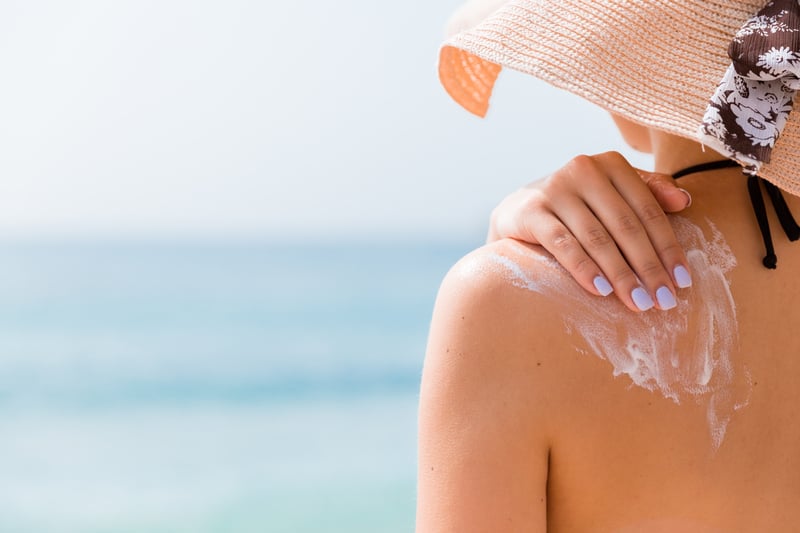Sunscreen: How to Choose, Use, and Properly Apply

If you live in the Northern Hemisphere, we’re almost there… Summer officially starts in less than a month. And of course, the sun is already shining. Shorts, tanks, and summer clothes are coming out of the closet. And it’s time to get your tan on (or not). Regardless of your tanning situation, chances are pretty good that you’ll be stepping into the (sun)light. And while there are numerous benefits of sunlight, it’s also very easy to cross over the line from health benefits to health risks. So, it’s important to choose, use, and just as importantly, know how to apply sunscreen properly to get the best out of your time outdoors.
How to Use (and Not Use) Sunscreen
You’ve probably heard the message loud and clear from the American Cancer Society, Skin Cancer Foundation, U.S. Public Health Service, and dermatologists around the globe that sunscreen should be applied every time you’re out in the sun. Summer, winter, spring, and fall. After all, you need to protect your skin from photoaging (including the breakdown of collagen, which can result in wrinkles, moles, and skin sagging), sunburn, and especially skin cancer (namely melanoma and squamous cell carcinoma).
While you absolutely do want to avoid sunburn (which increases your risk of skin cancer), there are also benefits of getting some sunshine—without sunscreen—at least a few times a week. In other words, the message of sun avoidance must be changed to acceptance of non-burning sun exposure. How can you strike the correct balance of blocking ultraviolet (UV) rays that can burn and potentially damage the skin while getting enough sunlight to produce enough Vitamin D (not to mention the countless other benefits of sun exposure)?
We’ve already covered much of the information on the sun, vitamin D, and your health, so here’s a quick summary:
- Skin cancer rates have been rising by 4.2% every year; the rates of melanoma have tripled over the last 35 years despite the push to use more and more sunscreen.
- UVR exposure leads to only 0.1% of the total global burden of disease in what’s known as Disability-Adjusted Life Years (i.e., DALYs).
- On the other hand, a significantly bigger annual disease burden of 3.3 billion DALYs is actually caused by too little UV exposure, which is associated with autoimmune diseases, heart disease, and deadly cancers. This is due, at least in part, to low levels of vitamin D from lack of sun exposure.
- Raising levels of 25-hydroxyvitamin D (the active form of vitamin D in the body) from the average of 15 – 18 ng/mL to 24 – 55 ng/mL may help decrease cancer rates drastically.
- Sufficient vitamin D levels help regulate at least 1,000 different genes (or ~10% of the total human genome).
- Getting sufficient sunlight first thing in the morning is also important for a healthy circadian rhythm, which is not only necessary for more restful, rejuvenating sleep, it regulates the expression of our genes.
- There are also risks to having too much vitamin D, so it’s worth it to have your blood tested annually, if possible, to see if you have too little, too much, or a healthy amount.
- Fair-skinned people need less sun exposure than those with darker skin tones to produce adequate levels of vitamin D, so recommendations vary. However, research suggests that enjoying about 15 minutes 2 to 3 times per week between 11:00 a.m. and 3:00 p.m. with about 40% of the skin exposed (e.g., face, arms, and legs) is a good balance of enough sunlight without getting too much. (But again, it does vary person to person and climate to climate. You may need just 10 minutes or over 30 minutes, depending on how sensitive your skin is to sunlight.)
With that being said, we also don’t want to downplay the potential negative effects of too much sun. Overexposure can lead to:
- Skin changes that can lead to looking older before your time due to wrinkles and hyperpigmentation (or age spots) as well as freckles and moles
- Dangerous (potentially deadly) skin cancers
- Lowered immunity
The worst-case scenario is to not get enough sun exposure most of the time, but when you do, you get burned.
So, before you do, it’s time to learn how to choose a quality sunscreen.
How to Choose a Quality Sunscreen
General recommendations for sunscreen suggest looking for “broad spectrum” protection that provides an SPF (sun protection factor) of 30 to 50, which filters out about 97% of UVB rays.
No sunscreen protects completely, and higher SPF can be deceptive and lead consumers to think their sunscreen is more effective than it really is. For example, you may think an SPF 100 sunscreen would be twice as protective as 50 SPF. It’s not. It’s actually only marginally more protective.
Plus, many sunscreens focus on protecting from UVB rays without considering UVA protection as well, which is why it’s so important to look for “broad spectrum” sunscreens.
In addition to watching out for products that offer inferior sun protection, it’s worth taking an extra step to avoid ingredients that can also be harmful to overall health. There is evidence that some of these harmful ingredients are absorbed through the skin and into the blood.
Fortunately, the Environmental Working Group (EWG) has assessed over 1,300 sunscreens. Sadly, only around one-quarter were found to offer adequate protection without concerning ingredients like oxybenzone, octanoate, and homovalvate, and other non-minerals that are readily absorbed into the skin and can have harmful effects on the body.
Other ingredients to avoid include vitamin A and types of vitamin A, such as retinyl palmitate, retinol, and retinoic acid, which can increase the risk of skin damage and skin cancer (by up to 21%).
As discussed in Is Sunscreen Actually Bad for You? “Other sunscreens contain methylisothiazolinone, which was named the ‘allergen of the year’ by the American Contact Dermatitis Society. And other common sunscreen ingredients shown to have toxic effects include octinoxate, homosalate, octisalate, octocrylene, para-aminobenzoic acid (PABA), cinnamates, padimate-o, and salicylates.”
The list of safe and effective ingredients for sunscreen is remarkably short. In fact, it just includes four: zinc oxide, titanium dioxide, avobenzone, and mexoryl SX. Some sunscreens also provide additional essential oils, but the research is not yet there to indicate how much more effective they make the sunscreen.
To help take out all the guesswork, fortunately, the EWG also put together a sunscreen guide to help you find the right sunscreen for your needs from best beach and sport sunscreens (180 options) to best sunscreens for kids (16 best scoring) to the best moisturizers with SPF (118 options). You can find that here: EWG’s 2020 Guide to Sunscreens
How to Apply Sunscreen Properly
Once you have picked up your quality sunscreen, that’s it. You’re done, right? Nope.
One of the biggest issues with sunscreen is that it is often applied incorrectly. Many people think all they need to apply sunscreen is to use a small amount quickly and go. However, a thick layer is typically needed to be fully effective. Rather than thinking of a dollop (or around a tablespoon) of sunscreen (which is about the right amount for your face alone), if you’re putting it on your body, you’ll seriously want to slather it on. The volume needed to cover your entire body is about what you’d find in a full shot glass or the size of a golf ball.
And don’t think that you can slather it on in the morning and then go through the entire day without a care in the world. If you’re outside for an extended amount of time, your sunscreen should be applied throughout the day—every two hours and immediately after you’ve been swimming or if you’ve gotten a good sweat on.
Especially when using a standard chemical sunscreen, you’ll also want to apply your sunscreen before you head outside as it can take about 15 minutes for the sunscreen to be absorbed into the skin, so it can start protecting you.
Most people are pretty good at ensuring their faces are well covered with sunscreen, but people often forget about the neck, top of the ears, lips, and exposed upper chest. (And if your hair is a bit thinner than it used to be or if you are exposing your scalp with a part, for example, don’t forget the top of your head.) Even if you have thick, lustrous hair, you’ll want to make sure you get around the scalp line. While you’re at it, make sure you’re covering all exposed skin.
If you are wearing sandals or going barefoot, please don’t forget to slather it on your feet. (That includes the tops and bottoms if you’re on the beach or at the pool, and they’re getting hit with direct sun.)
What about the ever-popular spray sunscreens? In short, spray sunscreens are not recommended as they not only don’t tend to cover as well, but you’re also likely to inhale some of the chemicals as you’re spraying it on. If you don’t want to absorb them through your skin, you certainly don’t want to breathe them in. Right?!
What if you’re staying inside? Do you really need to apply sunscreen every day? That depends. UVA radiation, which can penetrate the skin tissue more deeply and damage DNA and skin cells, leading to increased skin aging and cancer, can penetrate windows. If you sit next to a window, for example, as you work throughout the day, it may be a good idea to add a window film to block out those rays or choose to put on a good UVA-protecting sunscreen every day.
Now that you know how to safely choose, use, and how to apply sunscreen, there’s just one last thing to do—get outside and enjoy all of the benefits the outdoors can bring!







